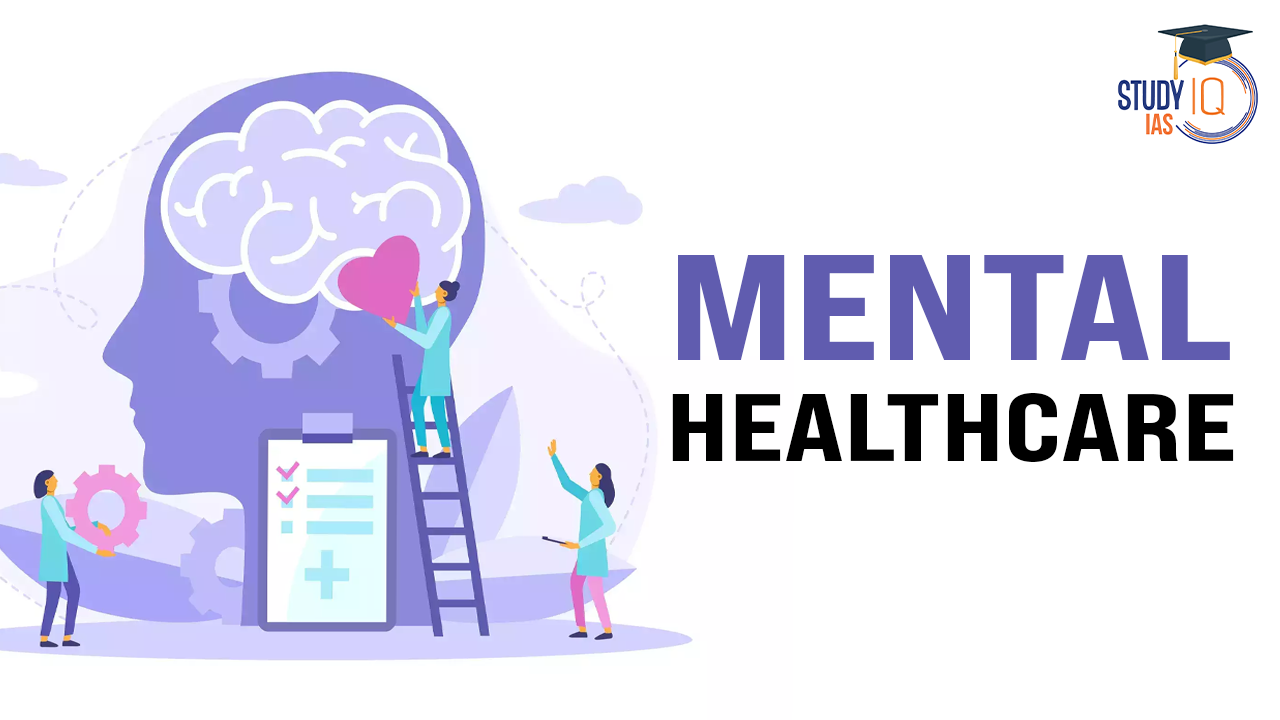Table of Contents
Context: India is facing a growing mental health crisis, with recent studies revealing high rates of depression, anxiety, and behavioural addictions, especially among youth. Despite various policy interventions and declining suicide rates, significant treatment gaps persist.
Mental Healthcare in India
Mental healthcare in India has been gaining more attention in recent years, but challenges remain. While the government has introduced policies like the Mental Healthcare Act of 2017, which ensures the right to access mental health services, the sector is still under-resourced. There is a significant shortage of mental health professionals, such as psychiatrists and psychologists, and stigma around mental illness persists.
However, awareness campaigns, the growth of telemedicine, and the involvement of NGOs and private organisations are helping to bridge gaps, offering hope for better access and reduced stigma in the future.
| Quotes |
|
Scope of Mental Health in India
- Widespread Prevalence: According to the National Mental Health Survey (2015-16), about 10.6% of India’s population has faced mental health issues, with 13.7% affected at the time of the survey.
- Recent studies show high prevalence among youth: 27% of children/adolescents experienced depression; 26% had anxiety disorders.
- Student suicide rates are alarming, with a 32% increase from 2017 to 2022.
- Behavioural addictions (internet, social media, gaming) are rising, affecting up to 40.7% of students in some states.
- Diverse Issues: Issues range from depression, anxiety, and suicide to newer concerns like internet and technology addiction, sleep disturbances, and family conflicts.
How Far Has India Reached?
- Declining Suicide Rates: India’s suicide rate declined from 19.1 (2000) to 12.9 (2019) per 100,000 persons, outpacing several developed nations.
- Policy Interventions: The National Mental Health Programme (since 1982), District Mental Health Programmes, and National Tele Mental Health Programme are in place.
- New initiatives like Tele-MANAS helpline and school-based interventions are being introduced.
Gaps Persist
- Treatment Gap: 71% of those with psychiatric disorders remain untreated (NMHS).
- Stigma and Awareness: Stigma, lack of awareness, and under-recognition prevent timely diagnosis and treatment, especially for behavioural addictions.
- Shortfall in Services: Insufficient inclusion of mental health in school curricula.
- Lack of adequately trained professionals in educational institutions and communities.
- Resource Allocation: Underinvestment in mental health services, particularly at the community and school level.
Why Do Schools Hold Strategic Importance?
- Early Intervention: Schools can identify, address, and prevent mental health issues early, especially among vulnerable youth.
- Influence on Risk Factors: Schools impact socio-emotional development, help build resilience, and can counteract risk factors like bullying and academic stress.
- Policy Emphasis: WHO and global mental health plans highlight schools as critical platforms for suicide prevention, awareness, and skill development.
- Community Impact: Schools can engage parents and communities, amplify mental health literacy, and destigmatise seeking help.
Key Strategies in Implementation and Call for Action
- Integration of Services: Incorporate digital mental health tools (e.g., Tele-MANAS) and establish Mental Health Advisory Boards (MHABs) in schools.
- Embed mental health education and resilience-building in school and college curricula.
- Capacity Building: Train teachers, parents, ASHA, and Anganwadi workers for early identification and psychological first aid.
- Include tele-counselling skills in psychology/social work courses.
- Structural Reforms: Mandate school mental health audits for accreditation from primary to higher education.
- Form school counsellor teams led by professionals to deliver services and train stakeholders.
- Community & Media Engagement: Encourage regular mental health coverage in newspapers, TV, and digital platforms.
- Run weekly programs and editorials to spread awareness and inform about treatment options.
- Special Task Forces: Establish district-level and national task forces focused on school and student mental health.
Role of Educational Regulatory Bodies in Mental Health
- Mandating mental health audits (from primary to higher education) for accreditation.
- Integrating tele-counselling skills into psychology and social work courses.
- Enforcing the establishment of Mental Health Advisory Boards (MHABs) (as per directives from the National Council of Educational Research and Training (NCERT)) in institutions.
- Supporting the training and formation of school counsellor teams led by mental health professionals.
What is Mental Health?
- The WHO defines mental health as “a state of mental well-being that empowers individuals to manage life’s challenges, recognise their abilities, learn and work effectively, and contribute to their community.
- Additionally, the WHO recognises mental health as a basic human right, essential for personal, community, and socio-economic development.
- Research indicates that positive mental well-being can lower the risk of heart attacks and strokes.
| About World Mental Health |
|
Check Here: World Mental Health Day
Rise in Workplace Suicides
- Global Trend: An alarming increase in suicides among young professionals has emerged, with excessive workplace stress identified as a primary cause.
- Crisis in Japan: The term ‘karoshi’ (death from overwork) is used in Japan, where 2,900 people committed suicide in 2023 due to overwork.
- Statistics in India: According to a Statista report, 11,486 suicides among Indian professionals in the private sector were recorded in 2022.
- Recent Incidents: In July, a 26-year-old woman executive from a multinational consulting firm took her life due to immense work pressures.
- In September, a 38-year-old software engineer with 15 years of experience in Chennai ended his life while being treated for depression linked to work stress.
- These incidents highlight the struggle between outward success and internal mental health challenges, such as depression and anxiety.
- Recent Incidents: In July, a 26-year-old woman executive from a multinational consulting firm took her life due to immense work pressures.
Reasons for Rising Stress and Anxiety
- The modern emphasis on efficiency and material wealth leads to a disconnection from self-awareness and contributes to the mental health crisis.
- Urban Pressures: The pressures of urban living, financial instability, and fierce competition contribute significantly to mental health issues.
- Many individuals find that material success does not equate to true well-being, leading to feelings of isolation and purposelessness.
- The focus on profit, efficiency, and cost-cutting leads to immense pressure on employees, resulting in long working hours and stressful conditions.
- Consumerism: A growing focus on consumerism fosters a culture where status is defined by luxury goods, resulting in stress and social comparison.
- This cycle of chasing material wealth neglects emotional and psychological needs.
Reasons for Poor Mental Health Status in India
- Lack of Awareness and Sensitivity: In India, mental health issues are often not regarded as healthcare concerns.
- Shortage of Mental Healthcare Personnel: India faces a severe shortage of mental health professionals.
- Example: National Mental Health Survey (2015-2016) highlighted that India has only 0.75 psychiatrists per 1 lakh population.
| Another Fact that can be used as an example |
|
- Treatment Gap: The National Mental Health Survey 2015-16 showed that 10.6 per cent of adults suffered from mental disorders in India, while the treatment gap for mental disorders ranged between 70 to 92 per cent for different disorders.
- Low Budget Allocation: While developed countries allocate 5-18% of their healthcare budget to mental health, India allocates just 1.11% (interim budget 203-24).
- Changed Lifestyle: The increased use of social media has heightened stress and mental illness, particularly among young people.
- Income Inequalities: Individuals living in poverty are at a higher risk of developing mental health conditions.
- Conversely, those with severe mental health issues are more likely to fall into poverty due to job loss and increased healthcare costs.
Key Initiatives Taken By The Government Of India For Improving Mental Health Care
- National Mental Health Survey (NMHS): Conducted by the National Institute of Mental Health and Neurosciences (NIMHANS) in Bengaluru in 2016.
- Found that approximately 10.6% of adults over the age of 18 suffer from mental disorders.
- District Mental Health Programme (DMHP): Launched as a key component of the National Mental Health Programme (NMHP).
- Implemented in 767 districts with support for States/UTs under the National Health Mission.
- Aims to provide:
- Suicide prevention services.
- Workplace stress management.
- Life skills training.
- Counselling for schools and colleges.
- Offers outpatient services, psycho-social interventions, continued care for severe mental disorders, drugs, outreach programs, and ambulance services through district hospitals, Community Health Centres (CHCs), and Primary Health Centres (PHCs).
- Provides a 10-bed inpatient facility at the district level.
- Over 73 lakh Sub Health Centres (SHCs) and PHCs have been upgraded to Ayushman Arogya Mandirs, integrating mental health services.
- Expansion of Tertiary Care Component: Expansion of the NMHP’s tertiary care component to enhance mental healthcare capacity.
- 25 Centres of Excellence sanctioned to increase intake in postgraduate departments specialising in mental health and provide tertiary treatment facilities.
- Strengthening of 47 postgraduate departments in mental health across 19 government medical colleges.
- Mental health services are provided in 22 newly established AIIMS.
- There are 47 government-run mental hospitals in India, including three central mental institutions:
- National Institute of Mental Health and Neuro Sciences, Bengaluru.
- Lokopriya Gopinath Bordoloi Regional Institute of Mental Health, Tezpur, Assam.
- Central Institute of Psychiatry,
- National Tele Mental Health Programme (NTMHP): Launched on October 10, 2022, to improve access to quality mental health counselling and care.
- 53 Tele MANAS Cells operational across 36 states/union territories.
- As of October 8, 2024, over 14.5 lakh calls have been handled through the helpline.
| Economic Survey 2023-24 Highlights |
Prevalence of Mental Health Disorders
Impact on Adolescents
Economic Impact of Mental Health Disorders
|
| International Practices |
| Brazil’s Initiatives: Community gardens in Brazil have successfully fostered social connections among residents. Similar initiatives in India could help mitigate the isolation caused by urban living. |
Way Forward
- Emphasis should be placed on mental, emotional, and social well-being rather than wealth accumulation.
- Mindfulness programs, social-emotional learning, and community living initiatives are essential to cultivate a culture valuing mental well-being.
- Social policies aimed at reducing inequality and providing mental health support are critical.
- Reassessing Work Culture: Companies should evaluate and adjust their work culture, reducing excessive hours, and embracing flexible schedules and remote work.
- Benefits of Flexibility: Employees with control over their schedules report higher satisfaction and lower stress levels.
- Encouraging Breaks and Vacations: Regular breaks and time off are essential in preventing burnout.
- Providing Psychological Support: Investment in employee assistance programs and access to mental health professionals is crucial. Early intervention can significantly mitigate long-term stress effects.
- Fostering Open Conversations: Creating a culture that encourages open discussions about mental health can help eliminate stigma.
- Training for Managers: Managers should be trained to recognize burnout signs and intervene proactively.
- Mental Health Check-Ins: Establishing routine mental health check-ins and prioritising stress management can foster a healthier workforce.
- Performance Metrics: Companies should shift focus from measuring productivity by hours worked to assessing the quality of work produced.
- Debunking Myths: The misconception that constant busyness equates to productivity needs to be addressed. A balanced work culture benefits both employees and organisations.
- Setting Realistic Expectations: Employers should set achievable goals, and employees must learn to set boundaries around their work hours, including the ability to say “no” when necessary.
- Collective Effort Required: Addressing workplace stress requires collaboration between employees and employers.
- Employee Resilience: Employees can build resilience through mindfulness, regular exercise, and strong social support networks.
- Seeking Professional Help: Prompt professional support is vital when stress becomes overwhelming.
Conclusion
Comprehensive, school-based mental health programmes are essential for promoting well-being, preventing illness, and reducing stigma. With strategic action and robust implementation, India can transform the mental health landscape for its youth and broader society.
| Related Articles | |
| National One Health Mission | National Digital Health Mission |


 Agricultural Monitoring and Event Detect...
Agricultural Monitoring and Event Detect...
 Genetically Modified Crops in India, Reg...
Genetically Modified Crops in India, Reg...
 What are Polycyclic Aromatic Hydrocarbon...
What are Polycyclic Aromatic Hydrocarbon...





















